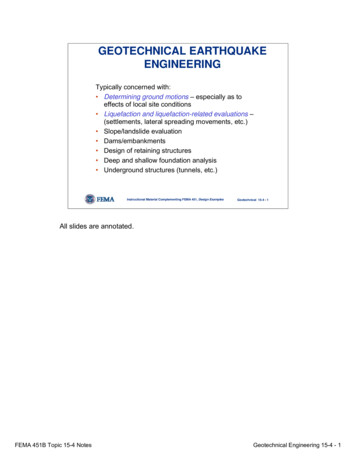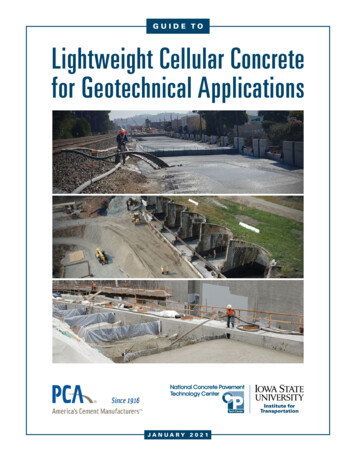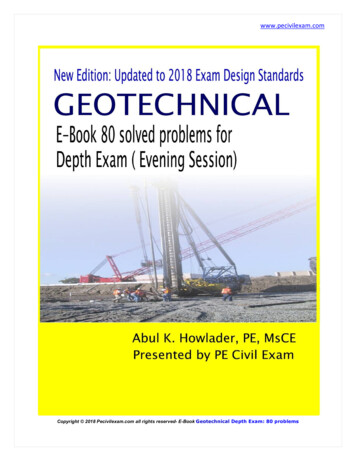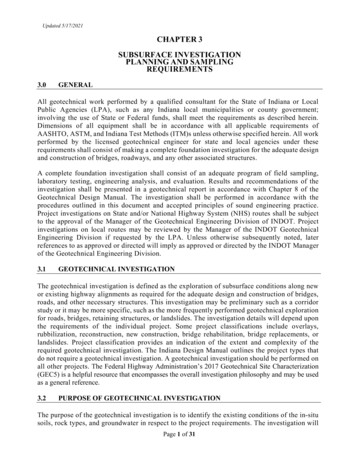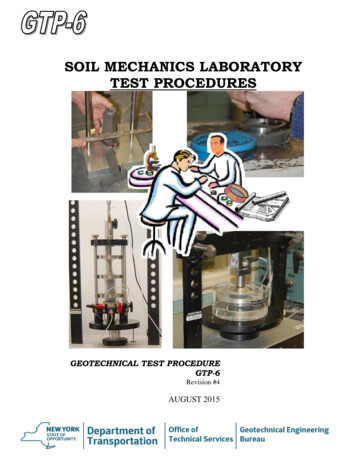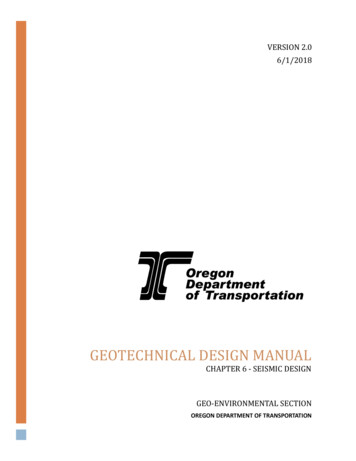
Transcription
VERSION 2.06/1/2018GEOTECHNICAL DESIGN MANUALCHAPTER 6 - SEISMIC DESIGNGEO-ENVIRONMENTAL SECTIONOREGON DEPARTMENT OF TRANSPORTATION
CHAPTER 6 - SEISMIC DESIGNTABLE OF CONTENTSSUMMARY OF CHANGES . 36SEISMIC DESIGN . 46.1GENERAL.46.1.1SEISMIC DESIGN STANDARDS . 46.1.2BACKGROUND. 56.1.3RESPONSIBILITY OF THE GEOTECHNICAL DESIGNER . 66.2SEISMIC DESIGN PERFORMANCE REQUIREMENTS .66.2.1NEW BRIDGES . 66.2.2BRIDGE WIDENINGS. 96.2.3BRIDGE ABUTMENTS AND RETAINING WALLS . 96.2.4BRIDGE APPROACH EMBANKMENTS, GENERAL EMBANKMENTS AND CUT SLOPES . 106.3GROUND MOTION PARAMETERS . 116.3.1SITE SPECIFIC PROBABILISTIC SEISMIC HAZARD ANALYSIS . 116.3.2MAGNITUDE AND PGA FOR LIQUEFACTION ANALYSIS . 126.3.3DEAGGREGATION OF SEISMIC HAZARD . 126.4SITE CHARACTERIZATION FOR SEISMIC DESIGN . 146.4.16.5SUBSURFACE INVESTIGATION FOR SEISMIC DESIGN. 15GEOTECHNICAL SEISMIC DESIGN PROCEDURES. 236.5.1DESIGN GROUND MOTION DATA . 256.5.2LIQUEFACTION ANALYSIS . 306.5.3SLOPE STABILITY AND DEFORMATION ANALYSIS . 396.5.4SETTLEMENT OF DRY SAND . 446.5.5LIQUEFACTION EFFECTS ON STRUCTURE FOUNDATIONS . 446.5.6MITIGATION ALTERNATIVES . 496.6INPUT FOR STRUCTURAL DESIGN . 516.6.16.7FOUNDATION SPRINGS . 51REFERENCES . 53APPENDIX . 57LIST OF TABLES . 57LIST OF FIGURES . 57LIST OF EQUATIONS . 57APPENDIX 6-A FLOW CHART FOR EVALUATION OF LIQUEFACTION HAZARD AND GROUND DEFORMATION ATBRIDGE SITES . 58APPENDIX 6-B ODOT LIQUEFACTION MITIGATION PROCEDURES . 60GEOTECHNICAL DESIGN MANUALPage 2 of 60
CHAPTER 6 - SEISMIC DESIGNSUMMARY OF CHANGESChapter6Summary of changes madeDate revisedUpdated All Chapter Content3/27/2018GEOTECHNICAL DESIGN MANUALPage 3 of 60
CHAPTER 6 - SEISMIC DESIGN6SEISMIC DESIGN6.1GENERALThis chapter describes ODOT’s standards and policies regarding the geotechnical aspects of the seismicdesign of ODOT projects. The purpose is to provide geotechnical engineers and engineering geologistswith specific seismic design guidance and recommendations not found in other standard designdocuments used for ODOT projects. Complete design procedures (equations, charts, graphs, etc.) areusually not provided unless necessary to supply, or supplement, specific design information, or if they aredifferent from standards described in other references. This chapter also describes what seismicrecommendations should typically be provided by the geotechnical engineer in the Geotechnical Report.6.1.1 SEISMIC DESIGN STANDARDSThe seismic design of ODOT bridges shall follow methods described in the most current edition (includingthe latest interims) of the “AASHTO Guide Specifications for LRFD Seismic Bridge Design” (AASHTO, 2011),the “AASHTO LRFD Bridge Design Specifications” (AASHTO, 2014), the “ODOT Bridge Design Manual”(BDM) and the recommendations supplied in this chapter. Refer to the ODOT BDDM for additional designcriteria and guidance regarding the use of the AASHTO Guide Specifications on bridge projects. The term“AASHTO” as used in this chapter refers to AASHTO LRFD design methodology. For seismic design of newbuildings the requirements prescribed by the Oregon Structural Specialty Code (Oregon Building CodesDivision, 2014), with reference to the International Building Code (International Code Council, 2012), shallbe used. Unless otherwise noted, the standards and policies described in this chapter supersede thosedescribed in the referenced documents.In addition to these standards, the following document should be referenced for additional designguidance in seismic design for issues and areas not addressed in detail in the AASHTO specifications orthis chapter:“LRFD Seismic Analysis and Design of Transportation Geotechnical Features and StructuralFoundations”, Geotechnical Engineering Circular No. 3. (Kavazanjian, et al. 2011).This FHWA document provides design guidance on earthquake engineering fundamentals, seismic hazardanalysis, ground motion characterization, site characterization, seismic site response analysis, seismicslope stability, liquefaction analysis, and soil-foundation-structure interaction for use in the seismic designof structure foundations and retaining walls.Additional reference documents for use in design are as follows: NCHRP Report 611 (Anderson et. al., 2008): “Seismic Analysis and Design of Retaining Walls, BuriedStructures, Slopes, and Embankments”, is a research project that developed analysis and designmethods, and recommended load and resistance factor design (LRFD) specifications, for the seismicdesign of retaining walls, slopes, embankments, and buried structures. Example problems for thedesign of retaining walls, slopes and embankments, and buried structures using LRFD methods areincluded in the report.Report No. FHWA-NHI-11-075 (Kavazanjian et al, 2011): “LRFD Seismic Analysis and Design ofTransportation Geotechnical Features and Structural Foundations, Design Examples”, is asupplement document to GEC-3 document (NHI Course #13094) containing useful examplesproblems demonstrating the use of LRFD seismic design principals in practice.NCHRP Report 472 (ATC-MCEER Joint Venture, 2002): “Comprehensive Specifications for the SeismicDesign of Bridges”, is a report containing the findings of a study completed to developrecommended specifications for seismic design of highway bridges. The report covers topicsGEOTECHNICAL DESIGN MANUALPage 4 of 60
CHAPTER 6 - SEISMIC DESIGNincluding design earthquakes and performance objectives, foundation design, liquefaction hazardassessment and design, and seismic hazard representation. Oregon Department of Transportation, Seismic web page This site provides the maps of 2014 USGS Probabilistic Seismic Hazard Analyses (PSHA) in the formof the Uniform Seismic Hazard, which reflects the contribution of all seismic sources in the regionon the ground motion parameters. The ground motion parameters (Peak Ground Acceleration(PGA), and acceleration response spectral ordinates at 0.2 and 1.0 seconds for Site Class B rock for500-year, 1,000-year return periods, specified as a percentage probability of exceedance in a givenexposure interval, in years. This website also provides the seismic hazard maps for the CascadiaSubduction Zone Earthquake (CSZE). Report No. FHWA-NHI-11-030 (Marsh et. al., 2011): “LRFD Seismic Analysis and Design of Bridges,Reference Manual”, is the reference manual for a comprehensive NHI training course that addressesthe requirements and recommendations of the seismic provisions in both the AASHTO LRFD BridgeDesign Specifications and the AASHTO Guide Specifications for LRFD Seismic Bridge Design. Topicsinclude force- and displacement-based design methodologies, the principles of capacity demand,methods for modeling and analyzing bridges subjected to earthquake motions, base isolation designand seismic retrofit strategies. Report No. FHWA-HRT-06-032 (Buckle et al., 2006): “Seismic Retrofitting Manual for HighwayStructures: Part 1 – Bridges.” United States Geological Survey; National Seismic Hazard Mapping Project. In the past the USGS National Seismic Hazard Maps website has been used for characterizing theseismic hazard for a specific site. However, in an effort to make the 2014 USGS National SeismicHazard Maps static the maps will be hosted at a different location which is not known at this time. WSDOT Geotechnical Design Manual, M46-03.11, 2015.The following two ODOT documents are available on the ODOT Geo-Environmental website for generalreference. Note that aspects of the analyses procedures outlined in these archival documents havesubsequently been updated and refined. The example problems included in these documents,demonstrating the application of selected seismic design procedures, are considered useful for generalguidance; however, practitioners should make use of the most current procedures. “Assessment and Mitigation of Liquefaction Hazards to Bridge Approach Embankments in Oregon”,Dickenson, S., et al., Oregon State University, Department of Civil, Construction and EnvironmentalEngineering, SPR Project 361, November, 2002.“Recommended Guidelines For Liquefaction Evaluations Using Ground Motions From ProbabilisticSeismic Hazard Analysis”, Dickenson, S., Oregon State University, Department of Civil, Constructionand Environmental Engineering, Report to ODOT, June, 2005.6.1.2 BACKGROUNDIn light of the complexity of seismic design of transportation facilities, continuous enhancements toanalytical and empirical methods of evaluation are being made as more field performance data is collectedand research advances the state of knowledge. New methods of analysis and design are continuouslybeing developed and therefore it is considered prudent to not be overly prescriptive in defining specificdesign methods for use in the seismic design process. However, a standard of practice needs to beestablished within the geotechnical community regarding minimum required design criteria for seismicdesign. It is well recognized that these standards are subject to change in the future as a result of furtherresearch and studies. This chapter will be updated as more information is obtained, new design codes areapproved and better design methods become available.Significant engineering judgment is required throughout the entire seismic design process. Therecommendations provided herein assume the geotechnical designer has a sound education andGEOTECHNICAL DESIGN MANUALPage 5 of 60
CHAPTER 6 - SEISMIC DESIGNbackground in basic earthquake engineering principles. These recommendations are not intended to beconstrued as complete or absolute. Each project is different and requires important decisions andjudgments be made at key stages throughout the design process. The applicability of these recommendedprocedures should be continually evaluated throughout the design process. Peer review may be requiredto assist the design team in various aspects of the seismic hazard and earthquake-resistant design process.Earthquakes often result in large axial and lateral loads being transferred from above ground structuresinto the structure foundations. At the same time, foundation soils may liquefy, resulting in a loss of soilstrength and foundation capacity. Under this extreme event condition it is common practice to allow thefoundations to be loaded up to the nominal (ultimate) foundation resistances (allowing resistance factorsas high as 1.0). This design practice requires an increased emphasis on quality control during theconstruction of bridge foundations since we are now often relying on the full, un-factored nominalresistance of each foundation element to support the bridge during the design seismic event.In addition to seismic foundation analysis, seismic structural design also involves an analysis of the soilstructure interaction between foundation materials and foundation structure elements. Soil-structureinteraction is typically performed in bridge design by modeling the foundation elements using equivalentlinear springs. Some of the recommendations presented herein relate to bridge foundation modelingrequirements and the geotechnical information the structural designer needs in order to do this analysis.Refer to Section 1.10.4 of the “ODOT Bridge Design Manual“ (BDDM) for more information on bridgefoundation modeling procedures.6.1.3 RESPONSIBILITY OF THE GEOTECHNICAL DESIGNERThe geotechnical designer is responsible for providing geotechnical/seismic recommendations and inputparameters to the structural engineers for their use in design of the transportation infrastructure. Specificelements to be addressed by the geotechnical designer include the following: design ground motionparameters, dynamic site response, geotechnical design parameters and geologic hazards. Thegeotechnical designer is also responsible for providing input for evaluation of soil-structure interaction(foundation response to seismic loading), earthquake induced earth pressures on retaining walls, and anassessment of the impacts of geologic hazards on the structures. Refer to Chapter 21 for geotechnicalseismic design reporting requirements.The seismic geologic hazards to be evaluated include fault rupture, liquefaction, ground failure includingflow slides and lateral spreading, ground settlement, and instability of natural slopes and earth structures.The seismic performance of tunnels is a specialized area of geotechnical earthquake engineering notspecifically addressed in this guidance document; however, the ground motion parameters determinedin the seismic hazard analyses outlined herein may form the basis for tunnel stability analyses (e.g., rockfall adjacent to portals and in unlined tunnels, performance of tunnel lining). The risk associated withseismic geologic hazards shall be evaluated by the geotechnical designer following the methods describedin this chapter.6.2SEISMIC DESIGN PERFORMANCE REQUIREMENTS6.2.1 NEW BRIDGESDesign new bridges on or West of US97 for a two-level seismic design criteria; Life Safety and Operational.Bridges east of US97 will be designed using the Life Safety seismic design criteria. Seismic Design Criteriafor Life Safety and Operational performance are described below.The ODOT Seismic website, listed below, should be referrenced to obtain the earthquake hazards anddesign tools associated with the Life Safety and Operational design Seismic.aspxGEOTECHNICAL DESIGN MANUALPage 6 of 60
CHAPTER 6 - SEISMIC DESIGN“Life-Safety” Design Criteria:Under this level of shaking, the bridge and approach structures, foundation and approach fills must beable to withstand the design forces and displacements without collapse of any portion of the structureand also be consistent with the Life Safety seismic design criteria described below and in the current ODOTBDDM. In general, bridges that are properly designed and detailed for seismic loads can accommodaterelatively large deflections without the danger of collapse.If large embankment displacements (lateral spread) or overall slope failure of the end fills are predicted,the impacts on the bridge end bent, abutment walls and interior piers should be evaluated to see if theimpacts could potentially result in collapse of any part of the structure. Slopes adjacent to a bridge ortunnel should be evaluated if their failure could result in collapse of a portion or all of the structure.Report ground motions having an average return period of 1000 years (7% probability of exceedance in75 years). Ground motion parameters shall be based on the 2014 USGS seismic hazard maps (Peterson,M.D., et. al., 2014). The probabilistic hazard maps for the 1,000-year and 500-year return periods areavailable at ODOT Seismic website listed above.To aid in consistency and efficiency, Bridge Section has developed an excel application, ODOT ARS.v.2014.16, for constructing the probabilistic design response spectrum using the general procedure (threepoint curve) for the 2014 data. ODOT ARS.v. 2014.16 has been released to incorporate the updated sitecoefficients associated with the 2014 hazard maps. The necessary inputs to generate a three pointresponse spectra include latitude, longitude, and site class. The tables below replace Tables 3.4.2.3-1, and3.4.2.3-2 in the AASHTO Guide Specifications for LRFD Seismic Bridge Design.Replace AASHTO Guide Spec Table 3.4.2.3-1 with tables 6.1 and 6.2:Table 6.1 Values of Site Factor, Fpga, at Zero-Period on Acceleration SpectrumSite ClassMapped Peak Ground Acceleration Coefficient (PGA)1PGA 0.1PGA 0.2PGA 0.3PGA 0.4PGA 0.5PGA ******GEOTECHNICAL DESIGN MANUALPage 7 of 60
CHAPTER 6 - SEISMIC DESIGNTable 6.2 Values of Site Factor, Fa, for Short-Period Range of Acceleration SpectrumSite ClassMapped Spectral Acceleration Coefficient at Period 0.2 sec (SS)1SS 0.25SS 0.5SS 0.75SS 1.0SS 1.25SS * Replace AASHTO Guide Spec Table 3.4.2.3-2 with following table:Table 6.3 Values of Site Factor, Fv, for Long-Period Range of Acceleration SpectrumSite ClassMapped Spectral Response Acceleration Coefficient at Period 1.0 sec (S1)1S1 0.1S1 0.2S1 0.3S1 0.4S1 0.5S1 41.842.2*41.742.0*Notes:1– Use straight-line interpolation for intermediate values of PGA, SS, or S1.2– Perform a site-specific geotechnical investigation and dynamic site response analysis for all sites in SiteClass F.3– Perform a ground motion hazard analysis for structures on Site Class E sites with SS greater than orequal to 1.0.4– Perform a ground motion hazard analysis for structures on Site Class D and E sites with S1 greater thanor equal to 0.2.“Operational” Design Criteria:In addition to the “Life Safety” performance design criteria, all bridges on and west of US Hwy 97 shall bedesigned to remain in service following a level of ground shaking associated with a full-rupture CascadiaSubduction Zone Earthquake (CSZE). Seismic hazard maps and spectral accelerations of CSZE have beendeveloped based on the full-rupture CSZE event. A summary of this work is provided the 2016 final reportto ODOT titled “Impact of Cascadia Subduction Zone Earthquake on the Evaluation Criteria ofBridges”.These maps are available on the ODOT Seismic web page. Also available on the web page, is aprogram developed by Portland State University (PSU) to generate a deterministic (eighteen points)GEOTECHNICAL DESIGN MANUALPage 8 of 60
CHAPTER 6 - SEISMIC DESIGNresponse spectra. A link to PSU’s program is located on the ODOT Seismic web page and is smic.aspx .For the Operational performance level, bridges and approach fills are designed to remain in service shortlyafter the event (after the bridge has been properly inspected) to provide access for emergency vehicles.Some structural damage is anticipated but the damage should be repairable and the bridge should be ableto carry emergency vehicles immediately following the earthquake. This holds true for the approach fillsleading up to the bridge.Approach fill settlement and lateral displacements should be minimal to provide for immediateemergency vehicle access for at least one travel lane. For mitigation purposes approach fills are definedas shown in Figure 6-15. As a general rule of thumb, an estimated lateral embankment displacement ofup to 1 foot is considered acceptable in many cases as long as the “operational” performance criteriadescribed above can be met and the structure foundations are adequately designed to withstand the soilloads resulting from the lateral displacements. Vertical settlements on the order of 6” to 12” may beacceptable depending on the roadway geometry, anticipated performance of the bridge end panels andthe ability of bridge foundation elements to withstand any imposed downdrag loads. Bridge end panelsare required on all state highway bridge projects (per BDDM) and should be evaluated for their ability towithstand the anticipated embankment displacements and settlement and still provide the required levelof performance. These displacement criteria are to serve as general guidelines only and engineeringjudgment is required to determine the final amounts of acceptable displacement that will meet thedesired criteria. It should be noted that these estimated displacements are not at all precise values andmay easily vary by factors of 2 to 3 depending on the analysis method(s) used. The amounts of allowablevertical and horizontal displacements should be decided on a case-by-case basis, based on discussions andconsensus between the bridge designer and the geotechnical designer and other appropriate projectpersonnel.In addition to bridge and approach fill performance, embankments through which cut-and-cover tunnelsare constructed should be designed to remain stable during the design seismic event because of thepotential for damage or possible collapse of the structure should they fail.Approach embankments and structure foundations should be designed to meet the above performancerequirements. Unstable slopes such as active or potential landslides and other seismic hazards such asliquefaction, lateral spread, post-earthquake settlement and downdrag may require mitigation measuresto ensure that the structure meets these performance requirements. Refer to Chapter 11 for guidance onapproved ground improvement techniques to use in mitigating these hazards.6.2.2 BRIDGE WIDENINGSFor the case where an existing bridge is to be widened and new foundation support is required, the seismicfoundation designs for the widened bridge should be designed using the same seismic design criteria as“New Bridges”. Consult with the bridge designer to determine the design and performance requirementsfor all new foundations required for bridge widening projects and/or the need for any Phase 2 retrofitdesign work.If Phase 2 foundation retrofit or liquefaction mitigation is necessary to meet the performance criteria,these designs shall be reviewed and approved by the HQ Bridge Section.6.2.3 BRIDGE ABUTMENTS AND RETAINING WALLSSeismic design performance objectives for bridge abutments shall be consistent with the designrequirements for the supported bridge. Seismic design performance objectives for retaining walls dependon the function of the retaining wall and the potential consequences of failure. There are four retainingwall categories, as defined in Chapter 15. The seismic design performance objectives for these fourGEOTECHNICAL DESIGN MANUALPage 9 of 60
CHAPTER 6 - SEISMIC DESIGNcategories are listed below. Refer to AASHTO, (2014) Article 11.5.4 for seismic design requirements forretaining walls under the Extreme Event Limit State condition. The Extreme Event I “no analysis”provisions of AASHTO Section 11 shall not apply to “Bridge Abutment Walls” or “Bridge Retaining Walls”. Bridge Abutments: Bridge Abutments are considered to be part of the bridge, and shall meet theseismic design performance objectives for the bridge see Section 6.2.1.Bridge Retaining Walls: Design all Bridge Retaining Walls for 1000-year return period groundmotions under the “Life Safety” bridge criteria. Under this level of shaking, the Bridge Retaining Wallmust be able to withstand seismic forces and displacements without failure of any part of the wallor collapse of any part of the bridge which it supports. Bridge Retaining Walls shall be designed foroverall stability under these seismic loading conditions, including anticipated displacementsassociated with liquefaction. Mitigation to achieve overall stability may be required.In addition, design all Bridge Retaining Walls for the ground motions described under the“Operational” bridge criteria. Under this level of shaking, Bridge Retaining Wall movement mustnot result in unacceptable performance of the bridge or bridge approach fill, as described underthe “Operational” criteria in Section 6.2.1.Highway Retaining Walls: Highway Retaining Walls should be designed for 1000-year return periodground motions unless the “No Analysis” option, as described in Article 11.5.4 of AASHTO (2014), isapplicable. Under this level of shaking, the Highway Retaining Wall must be able to withstandseismic forces and displacements without failure of any part of the Highway Retaining Wall. HighwayRetaining Walls shall be designed for overall stability under these seismic loading conditions,including anticipated displacements associated with liquefaction. Mitigation to achieve overallstability may be requiredMinor Retaining Walls: Minor Retaining Wall systems have no seismic design requirements.The policy to design all Highway Retaining Walls to meet overall stability requirements for seismicdesign may not be practical at all wall locations. Where it is not practical to design a HighwayRetaining Wall for overall stability under seismic loading, and where a failure of this type would notendanger the public, impede emergency and response vehicles along essential lifelines, or have anadverse impact on another structure, the local Region Tech Center should evaluate practicablealternatives for improving the seismic resistance and performance of the retaining wall.In general, retaining walls and bridge abutments should not be built on or near landslides or otherareas that are marginally stable under static conditions. However, if site conditions, projectconstraints (cost), prohibit an effective technical alternative, the local Region Tech Center willevaluate, on a case-by-case basis, the possible placement of these structures in these locations,as well as requirements for global (overall) instability of the landslide during the design seismicevent.6.2.4 BRIDGE APPROACH EMBANKMENTS, GENERAL EMBANKMENTS AND CUT SLOPESBridge approach embankments should be evaluated for seismic slope stability and settlement in all areaswhere the ground surface acceleration coefficient (As) is 0.15g., especially if they are relied upon toprovide passive soil resistance behind the abutment (Earthquake-Resisting System). Bridge approachembankments (with or without retaining walls) should be designed to meet the operational and life safetyperformance requirements described in Section 6.2.1 and in accordance with all other applicable sectionsof this chapter.Cut slopes, fill slopes, and embankments that are not bridge approach embankments are generally notevaluated for seismic instability unless they directly affect a bridge, highway retaining wall or otherstructure. Seismic instability associated with routine cuts and fills are typically not mitigated due to thehigh cost of applying such a design policy uniformly to all slopes statewide. If failure and displacement ofexisting slopes, embankments or cut slopes, due to seismic loading, could adversely impact an adjacentGEOTECHNICAL DESIGN MANUALPage 10 of 60
CHAPTER 6 - SEISMIC DESIGNstructure or facility, these areas should be considered for stabilization. Such impacts should be evaluatedin terms of meeting the performance criteria described in Section 6.2.6.3GROUND MOTION PARAMETERSThe ground motion parameters for the Life Safety design criteria are based on the 2014 USGS NationalSeismic Hazard Mapping Project. These maps provide the results of probabilistic seismic hazard analysis(PSHA) at the regional scale. Ground motion maps and design parameters for the Life Safety (1000-yearPSHA) design criteria are available on the ODOT Seismic web page. The designer should review the basisof these hazard maps and have a thorou
GEOTECHNICAL DESIGN MANUAL Page 4 of 60 6 SEISMIC DESIGN 6.1 GENERAL This chapter describes ODOT’s standards and policies regarding the geotechnical aspects of the seismic design of ODOT projects. The purpose is to provide geotechnical engineers and engineering geologists with specific seismic


